Cryptocurrency miners use powerful computers to solve complex math puzzles that validate transactions on a blockchain. When miners successfully solve these puzzles, they add new blocks to the chain and receive newly created cryptocurrency as a reward. Many miners join pools to combine computing power and increase their chances of earning rewards. The process consumes significant electricity, leading some to seek renewable energy solutions. Understanding mining operations reveals the backbone of digital currency systems.

Thousands of cryptocurrency miners around the world compete every day to earn digital money by solving complex math puzzles. These miners aren't solving puzzles with pencil and paper. They're using powerful computers that work non-stop to validate transactions and add new blocks to a blockchain, which is a digital ledger that records all transactions of a cryptocurrency.
Thousands compete daily, solving digital puzzles with powerful computers to add blocks to blockchain ledgers.
The mining process is essential for cryptocurrencies like Bitcoin to function properly. Miners use their computers to verify transactions and prevent the same digital coins from being spent twice. They compete to solve mathematical problems that require many calculations. The first miner to solve the puzzle gets to add a new block to the blockchain and receives newly created cryptocurrency as a reward. This security mechanism, known as Proof-of-Work, prevents fraud and maintains the integrity of the cryptocurrency network.
Different types of hardware can be used for mining. Bitcoin miners typically use devices called ASICs (Application-Specific Integrated Circuits), which are built solely for mining. Other cryptocurrencies are mined using GPUs (Graphics Processing Units) found in gaming computers. In the early days, regular computer processors (CPUs) were enough, but they're now too slow for profitable mining of most cryptocurrencies. Monero is a notable exception as it is specifically designed for CPU mining using the RandomX algorithm.
Mining requires specialized software to run the hardware. This software connects miners to the blockchain, distributes tasks among mining devices, and shows performance statistics. Popular mining programs include CGMiner, BFGMiner, and EasyMiner. The software allows miners to join forces with others in what's called a mining pool.
Mining pools are groups of miners who combine their computing power to increase their chances of earning rewards. When a pool successfully mines a block, the reward is split among members based on how much computing power each contributed. This approach provides more steady income for miners compared to mining alone.
The energy used in cryptocurrency mining has become a major concern. Bitcoin alone uses as much electricity as some small countries – about 120 terawatt-hours per year as of 2023. That's why miners often set up in places with cheap electricity. Many are now turning to renewable energy sources to reduce costs and environmental impact. Each mining operation requires extensive cooling systems as the continuous operation of equipment generates significant heat.
Whether mining is profitable depends on several factors: the price of the cryptocurrency, the difficulty of mining (which adjusts as more miners join the network), the cost of mining equipment, electricity prices, and the total computing power of all miners on the network.
Mining regulations vary widely across the world. Some countries have banned it completely, like China did in 2021. Others have welcomed miners with open arms. As concerns about energy use grow, more governments are considering new rules for cryptocurrency mining.
Frequently Asked Questions
How Much Electricity Do Mining Operations Consume?
Bitcoin mining operations consume an estimated 150-170 terawatt-hours of electricity annually.
This equals about 0.5-0.6% of global electricity use, similar to what entire countries like Argentina or Poland use.
The operations generate 110-130 million tons of CO2 each year.
Energy consumption rises and falls with Bitcoin's price and mining difficulty.
The U.S. leads with 35-40% of global mining activity.
Can I Mine Cryptocurrency on My Regular Home Computer?
Mining cryptocurrency on a regular home computer is possible but challenging.
Home PCs can mine Monero, which is designed for CPU mining. GPU mining works better for other cryptocurrencies but requires powerful graphics cards.
Most home mining isn't profitable due to electricity costs exceeding rewards. Joining mining pools can increase chances of earning small rewards.
ASIC-resistant cryptocurrencies offer better opportunities for home miners.
What Are the Environmental Impacts of Cryptocurrency Mining?
Cryptocurrency mining carries significant environmental costs.
Bitcoin alone uses as much electricity as Argentina annually, producing CO2 emissions comparable to Greece.
Mining operations consume massive amounts of water—equivalent to 660,000 Olympic swimming pools from 2020-2021.
They also generate substantial e-waste from outdated equipment.
However, the industry is evolving, with over 50% of Bitcoin mining now using renewable energy and Ethereum reducing its energy use by 99.9%.
How Long Does It Take to Mine One Coin?
Mining time varies dramatically between cryptocurrencies.
Bitcoin takes 10 minutes per block, but an individual miner with 100 TH/s would need about 28.5 years to mine one Bitcoin. Newer miners with 390 TH/s still need 4,574 days.
Other coins mine faster – Litecoin takes about 4 days with specialized equipment, while 1,000 Dogecoin can be mined in a day.
Are Some Cryptocurrencies Easier to Mine Than Others?
Yes, some cryptocurrencies are easier to mine than others.
Factors like algorithm complexity, network hash rate, and hardware requirements create these differences.
Coins like Monero, Ravencoin, and Vertcoin are generally easier to mine because they're designed to be ASIC-resistant, allowing regular computers to participate.
Meanwhile, Bitcoin and Litecoin require specialized, expensive equipment due to their high mining difficulty and competitive environment.










